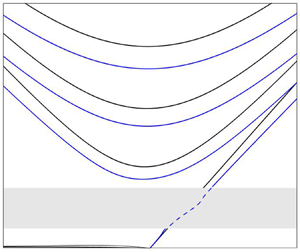Article contents
Wave propagation in rotating shallow water in the presence of small-scale topography
Published online by Cambridge University Press: 28 July 2021
Abstract

The question of how finite-amplitude, small-scale topography affects small-amplitude motions in the ocean is addressed in the framework of the rotating shallow water equations. The extent to which the dispersion relations of Poincaré, Kelvin and Rossby waves are modified in the presence of topography is illuminated, using a range of numerical and analytical techniques based on the method of homogenisation. Both random and regular periodic arrays of topography are considered, with the special case of regular cylinders studied in detail, because this case allows for highly accurate analytical results. The results show that, for waves in a  $\beta$-channel bounded by sidewalls, and for steep topographies outside of the quasi-geostrophic regime, topography acts to slow Poincaré waves slightly, Rossby waves are slowed significantly and Kelvin waves are accelerated for long waves and slowed for short waves, with the two regimes being separated by a narrow band of resonant wavelengths. The resonant band, which is due to the excitation of trapped topographic Rossby waves on each seamount, may affect any of the three wave types under the right conditions, and for physically reasonable results requires regularisation by Ekman friction. At larger topographic amplitudes, for cylindrical topography, a simple and accurate formula is given for the correction to the Rossby wave dispersion relation, which extends previous results for the quasi-geostrophic regime.
$\beta$-channel bounded by sidewalls, and for steep topographies outside of the quasi-geostrophic regime, topography acts to slow Poincaré waves slightly, Rossby waves are slowed significantly and Kelvin waves are accelerated for long waves and slowed for short waves, with the two regimes being separated by a narrow band of resonant wavelengths. The resonant band, which is due to the excitation of trapped topographic Rossby waves on each seamount, may affect any of the three wave types under the right conditions, and for physically reasonable results requires regularisation by Ekman friction. At larger topographic amplitudes, for cylindrical topography, a simple and accurate formula is given for the correction to the Rossby wave dispersion relation, which extends previous results for the quasi-geostrophic regime.
- Type
- JFM Papers
- Information
- Copyright
- © The Author(s), 2021. Published by Cambridge University Press
References
REFERENCES
- 7
- Cited by



